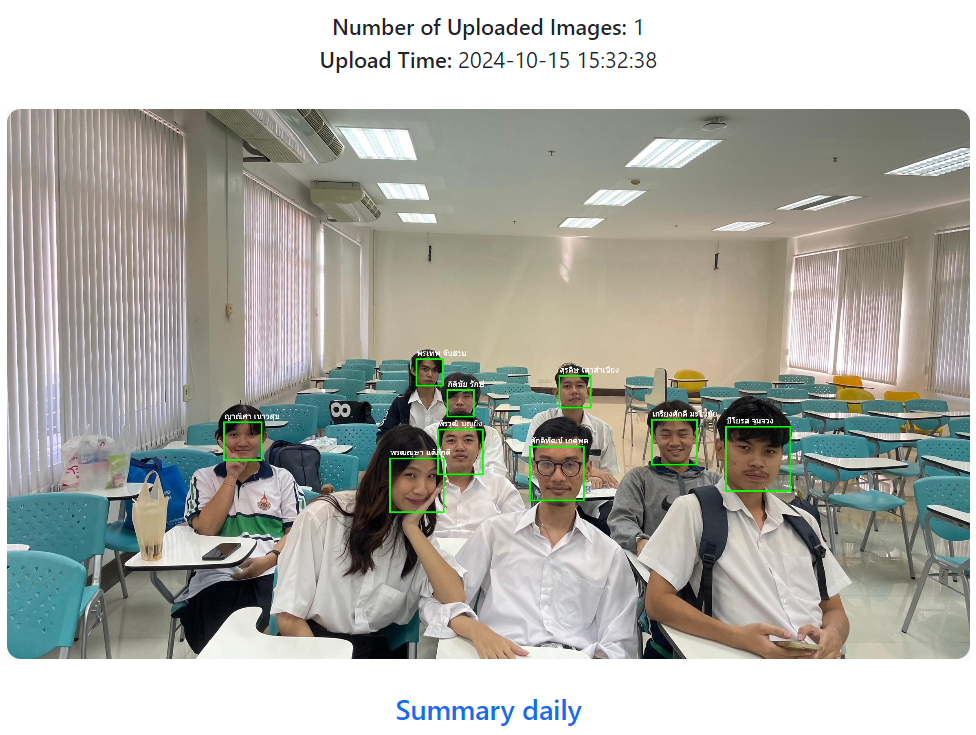Time Attendance System with Face Recognition Using CNN and Deep Learning
Main Article Content
Abstract
This research aims to evaluate the accuracy and performance of a classroom attendance system utilizing facial detection with CNN and Deep Learning. It also aims to develop a facial recognition-based attendance system that effectively minimizes data recording errors. The facial recognition model was developed using Deep Learning techniques, particularly Convolutional Neural Networks (CNN), combined with the Histogram of Oriented Gradients (HOG) facial detection technology. The application was developed using Python, while the website interface was built using PHP and React.js. User databases and attendance reports were stored in MySQL. The system was tested under indoor lighting conditions at face detection distances of 2, 3, 4, and 5 meters, with target face counts of 4, 6, 8, 10, 12, 14, and 16 people. Each condition was tested 20 times. The results can be summarized as follows: 1) For optimal accuracy and efficiency, the system requires clear facial features (e.g., eyes, nose, mouth, and forehead) for recognition. 2) The most accurate results were achieved at a detection distance of 2 meters with 4 target faces per image, yielding an average accuracy of 100%. 3) The least accurate results were observed at a detection distance of 5 meters with 16 target faces per image, with an average accuracy of 30%. 4) Facial detection accuracy decreases as the resolution of facial details in the image decreases. 5) The average facial detection accuracy across all test conditions was 75%.
Article Details

This work is licensed under a Creative Commons Attribution-NonCommercial-NoDerivatives 4.0 International License.
References
A. A. M. Alshiha, M. W. Al-Neama, and A. R. Qubaa, " Parallel Hybrid Algorithm for Face Recognition Using Multi-Linear Methods," International Journal of Electrical and Electronics Research, vol. 11, no. 4, pp. 1013–1021, Nov. 2023.
Z. Li, F. Liu, W. Yang, S. Peng and J. Zhou, " A Survey of Convolutional Neural Networks: Analysis, Applications, and Prospects,", IEEE Transactions on Neural Networks and Learning Systems, vol. 33, no. 12, pp. 6999-7019, Dec. 2022.
S. Sakib, N. Ahmed, A. J. Kabir, and H. Ahmed, "An overview of convolutional neural network: Its architecture and applications," Bangladesh: Preprints, 2018.
R. Yamashita, M. Nishio, R. K. G. Do, and K. Togashi, "Convolutional Neural networks: an Overview and Application in Radiology," Insights into Imaging, vol. 9, no. 4, pp. 611–629, Jun. 2018.
S. R. Dubey, S. K. Singh, and B. B. Chaudhuri, “Activation functions in deep learning: A comprehensive survey and benchmark,” Neurocomputing, vol. 503, pp. 93–108, Sep. 2022.
A. Zafar, M. Aamir, N. Mohd Nawi, A. Arshad, S. Riaz, A. Alruban, A. K. Dutta, and S. Almotairi, “A Comparison of Pooling Methods for Convolutional Neural Networks,” Applied Sciences, vol. 12, no. 17, p. 8643, Jan. 2022.
X. Zhao, L. Wang, Y. Zhang, X. Han, M. Deveci, and M. Parmar, "A review of convolutional neural networks in computer vision," Artificial Intelligence Review, vol. 57, pp. 99–142, Mar. 2024.
Nwankpa, C. E., Ijomah, W., Gachagan, A., and Marshall, S. “Activation functions: comparison of trends in practice and research for deep learning,” in Proc. 2nd International Conference on Computational Sciences and Technology, Jamshoro, Pakistan. 2021. pp.123 - 133.
P. Carcagnì, M. Del Coco, M. Leo, and C. Distante, "Facial expression recognition and histograms of oriented gradients: a comprehensive study," SpringerPlus, vol. 4, no. 645, pp. 1–25, 2015.
W. Zhou, S. Gao, L. Zhang, and X. Lou, "Histogram of Oriented Gradients Feature Extraction from Raw Bayer Pattern Images," IEEE Transactions on Circuits and Systems II: Express Briefs, vol. 67, no. 12, pp. 3502–3506, Dec. 2020.
Chaiyadecha, S., "Image Classification: Histogram of Oriented Gradients," Medium, Mar. 23, 2022. [Online]. Available: https://lengyi.medium.com/image-classification-histogram-of-oriented-gradients-87ab7b657b6b.
S. S. Umar, Z. S. Iro, A. Y. Zandam, and S. S. Shitu, "Accelerated Histogram of Oriented Gradients for Human Detection," Dutse Journal of Pure and Applied Sciences (DUJOPAS), vol. 9, no. 1a, pp. 44–56, Mar. 2023.
L. Ke and Y. Luo, "A new pedestrian detection method based on histogram of oriented gradients and support vector data description," in Electronics, Communications and Networks, vol. 10, pp. 333–342, 2024.
อรวรรณ เลียบศิริ, "การจำแนกอารมณ์ตัวการ์ตูนด้วยฮิสโตแกรมของทิศทางตามค่าเกรเดียนท์," วิทยานิพนธ์ วท.ม. (วิทยาการคอมพิวเตอร์) มหาวิทยาลัยธรรมศาสตร์, กรุงเทพฯ, 2559.
Mahmoudi, K., "Understanding Histogram of Oriented Gradients (HOG) for Face Detection," Kaamraan, Jan. 22, 2024. [Online]. Available: https://kaamraan.com/understanding-histogram-of-oriented-gradients-hog-for-face-detection/?fbclid=IwY2xjawHm4VpleHRuA2FlbQIxMAABHScZFsJCy47aTiivHij-tn9OSpAqphhex2hSZ3QNv1WORKeIdA5T8q7jpA_aem_5X4rPpW9wc8LUBOho_Y5zg.
ชลิดา ภัทรณิชกุล, "ระบบการจดจำใบหน้าของบุคคลโดยใช้การเรียนรู้เชิงลึกและการเรียนรู้ของเครื่อง" วิทยานิพนธ์ วศ.ม. (วิศวกรรมไฟฟ้า) มหาวิทยาลัยศรีนครินทรวิโรฒ, กรุงเทพฯ, 2566.
เอกรัตน์ สุขสุคนธ์, "ระบบลงทะเบียนใบหน้าและตรวจสอบนักศึกษาเข้าห้องเรียน ด้วยหลักการ ประมวลผลภาพร่วมกับเทคนิคการรู้จำใบหน้า,"วารสารวิชาการสมาคมสถาบันอุดมศึกษาเอกชนแห่งประเทศไทย, ปีที่ 10, ฉบับที่ 2, หน้า 30-39, กรกฎาคม – ธันวาคม, 2564.
ศันศนีย์ หิรัญจันทร์ และจิระ ทิวถาวรวงศ์ (2563). "ระบบตรวจจับหน้าใบหน้าเพื่อยืนยันตัวบุคคลเพื่อสนับสนุนระบบทะเบียนอาชญากร," วารสารวิทยาศาสตร์ เทคโนโลยีและนวัตกรรม, ปีที่ 1, ฉบับที่ 6, หน้า 1-7, พฤศจิกายน – ธันวาคม, 2563.
ณัฐชนนท์ ภูกลาง, ณสิทธิ์ เหล่าเส็น, พิทา จารุพูนผล, และ ธนกฤษ จันทร์แสง, "ระบบลงเวลาการเข้าทำงานด้วยเทคโนโลยีการจดจำใบหน้าในช่วงการแพร่ระบาดของโควิด-19," ใน รายงานการประชุมและนำเสนอผลงานวิชาการระดับชาติด้านการศึกษา ครั้งที่ 2, มหาวิทยาลัยราชภัฏชัยภูมิ, 2565.
อะดาว น้องวี, บุญชัย แซ่สิ้ว และศุภรัชชัย วรรัตน์, “การประยุกต์ใช้เทคโนโลยีการรู้จำใบหน้าเพื่อบันทึกเวลาเข้าออกของพนักงาน,” วารสารการจัดการเทคโนโลยี มหาวิทยาลัยราชภัฏมหาสารคาม, ปีที่ 8, ฉบับที่ 1, หน้า 99–113, มกราคม–มิถุนายน, 2564.

